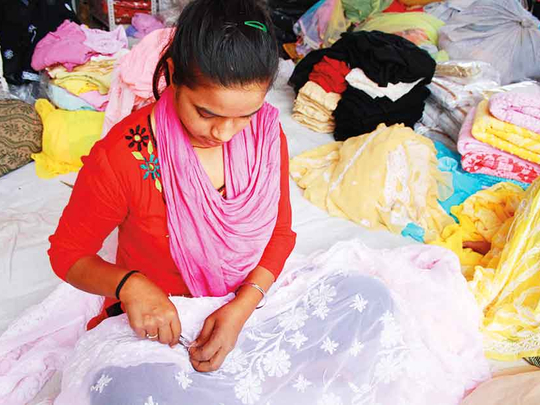
LUCKNOW: Mention the fact that you are visiting Lucknow, and the first thing you will be advised is: “While you are there, don’t miss out on buying chikankari kurtas.” Reminiscent of the exquisite needlework designs of birds, flowers, butterflies and fishes that exemplified the artistic expressions of the Mughal era, chikankari garments continue to delight people not only in India but also around the world and their appeal cuts across age and culture.
Lucknow, the capital of the state of Uttar Pradesh and largest city in northern India, is synonymous with chikankari, the over 400-year-old art of beautiful embroidery on cotton fabric, famous since the period of the British and the nawabs.
- Sumit | Manufacturer
Heera Rastogi , a Lucknow-based proud fourth generation connoisseur of this fine art, said, “The word chikan is derived from the word Chikeen meaning a drapery wrought with needlework. Though it began as white-on-white embroidery on cotton fabric, cool pastel shades of threads were later introduced on a variety of fabrics like muslin, silk, chiffon, organza and net. In recent times, it also adapted additional embellishments like sequins, beads and mirror work, which stormed the markets to meet the fashion trends and keep chikankari up-to-date.”
The embroidery, usually consisting of floral motifs, stems and creepers, are either done all over the garment or on borders. A simple craft that has elevated itself into an art form, chikankari enjoys a distinctive place for itself in the hall of embroidery forms for the beauty and elegance it lends to the fabric, and by extension to the wearer of the garment.
Another manufacturer of chikankari, Sumit highlighted the extraordinary legacy of this craft work that has stood the stest of time and the vagaries of fashion. “The thousands of block patterns integral to the look of chikankari have been doing the rounds for years, without going out of fashion. As with any other weaving technique, chikankari requires immense discipline and methodology.
“It’s not about the names of stitches, but how the needle moves on the fabric that makes the difference,” he said.
Rastogi explained the pre and post preparation techniques that go into the making of this art. “It begins with the fabric that is cut according to the garment it will form. Referred to as block printing, the wooden blocks are stamped onto the fabric forming the designs in blue ink. These designs are then set within a small round frame, part by part, as the needlework begins to trace the ink printed patterns. The type of stitch an artisan chooses depends on the specialty of the region and requirement of the size of motifs. Once the entire fabric is hand embroidered, it is soaked in water to remove the pattern outlines. Occasionally, it is starched to obtain the right stiffness depending on the fabric. This is a home-based industrial activity, performed by both men and women. While men undertake the work of block printing and laundering, embroidery is predominantly women’s work. The finished garment is first checked for consistency and neatness and then sent into the market.”
Chikankari is highly time consuming and artisans were trained for years before mastering this art. Depending on the pattern, intricacy and size of the fabric, the embroidery process alone can take from 10 days to a couple of months to complete it.
But as with every form of traditional craft, technology and the shifting socio-economic sands leave their impact on them and so it is with chikankari. Women artisans Shyama, Neelam and Saloni rue their economic plight.
“While successive governments changed the policies for the promotion of chikankari from time-to-time, the socio-economic status of the workers has remained in a pathetic condition,” said Neelam. “No organised efforts were made to promote chikankari as an industry. In addition, there is no true appreciation by people of the hard work we put into creating these masterpieces.”
And those involved in the industry in Lucknow, such as Preeti, who exports the garments to the US, UK, Australia, New Zealand and the Middle East, remain committed to making chikankari a lasting thing of beauty. “Chikankari remains a global sensation and our aim is to introduce this ancient artwork across the world and not let it remain limited to India,” said Preeti.
Mysterious art
While the exact origin of this technique remains a mystery, some historians have recorded the presence of chikan work during the 3rd Century BC that mentioned the use of flowered muslins by Indians. Yet another version is that the Mughals introduced this craft to India in the 17th century. Emperor Jahangir’s consort Noor Jahan was known for her dexterity in embroidery, with a penchant for chikankari. The emperor was also enamoured by this craft and he patronised it by establishing several workshops to hone and perfect this art form. During his era, the fabrics used were muslin and mulmul, the finest of cotton weaves, which are best suited for warm and sultry weather conditions.
There are also tales that a traveller taught the art to a peasant in return for water offered to quench his thirst, so that the poor peasant and his family would be able to earn a living through this art and never starve. The art flourished, as the craft was passed on to the womenfolk of the community as a source of subsidiary earning for the family. Gradually, it became the main source of earning of the family and continues to do so.












